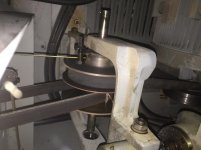benha
Plastic
- Joined
- Aug 14, 2012
- Location
- San Francisco, CA
So I've been running my lathe a fair bit over the last couple of days, doing something I rarely do which is turning between centers.
To make a long story short, I had a scare where I thought I'd buggered the spindle bearings, but what it really turned out to be was that the idler shaft that supports the pulleys between the motor belt and the spindle belt had migrated out of the outside bearing and the pulleys/belts were cattywompus.
See photo.
Looking at the service manual, there doesn't appear to be anything to retain the shaft. Looks like it just floats free in there. That seems remarkable...
Is this a "common" issue that people just keep their eye on? Or is it a symptom of something I should be trying to fix?

To make a long story short, I had a scare where I thought I'd buggered the spindle bearings, but what it really turned out to be was that the idler shaft that supports the pulleys between the motor belt and the spindle belt had migrated out of the outside bearing and the pulleys/belts were cattywompus.
See photo.
Looking at the service manual, there doesn't appear to be anything to retain the shaft. Looks like it just floats free in there. That seems remarkable...
Is this a "common" issue that people just keep their eye on? Or is it a symptom of something I should be trying to fix?





